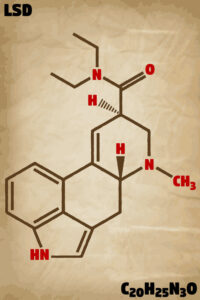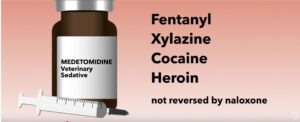
Bill W., the co-founder of Alcoholics Anonymous, has an acknowledged history of LSD use in the 1950s. This was when LSD was an unknown, experimental chemical, with no regulations or restrictions regulating its use. The A.A. published story of Bill Wilson and how the A.A. message reached the world, Pass It On, openly discussed Bill’s interest in LSD. It mentioned individuals who were known by or became friends to Bill—Gerald Heard, Aldous Huxley and Humphry Osmond—and who also happen to be important figures in the history of psychedelics. Yet by 1959, “Bill had personally withdrawn from the LSD experiments,” so that he would not compromise the future of A.A. But there is more to the story of Bill W. and LSD than what is found in Pass It On.
It began in the winter of 1943-44 when Bill and his wife Lois set out on a cross-country trip visiting A.A. groups that had sprouted up since the 1939 publication of the Big Book. According to Susan Cheever in My Name is Bill, Bill and Lois met Gerald Heard and Aldous Huxley while they were in Palo Alto, California and there was an immediate attraction between Wilson and Huxley. Heard and Huxley believed the betterment of society would come from an experiment in community and community education. Bill and A.A. were the practical application of that philosophy. Heard and Huxley invited Bill and Lois to spend New Year’s week at Trabuco College, a retreat center in the desert established by Heard to study comparative religion, and research meditation and prayer. The Wilsons returned to New York on January 22, 1944, but an important friendship was formed.
Pass It On said Bill and Huxley had an immediate rapport, one that Bill was immensely proud of. “They had much in common, although Huxley was not an alcoholic.” Huxley would later say he considered Bill to be a “modern saint” and “the greatest social architect of the twentieth century.” It was through Bill’s friendship with Huxley that Bill first heard about, and eventually decided to try LSD.
Humphry Osmond began his research with LSD and mescaline at St. George’s Hospital in London, where he was employed after WW II. In 1951, he moved to Saskatchewan, Canada to join the staff at Weybrun Mental Hospital. At Weybrun he organized the hospital as a design-research laboratory where he conducted a variety of studies into the use of hallucinogenic drugs. He was initially investigating the possibility that schizophrenia arose primarily from distortions of perception similar to those experienced by individuals under the influence of mescaline or LSD. But unexpectedly, Osmond began to see the potential of these drugs to foster mind-expanding, mystical experiences. It was during this time of experimentation that Aldous Huxley began a correspondence with Osmond and eventually asked him if he would kindly supply Huxley with a dose of mescaline.
In May of 1953 Osmond traveled to the Los Angeles area for a conference, where he provided the requested dose of mescaline and supervised Huxley’s experience with mescaline. Huxley would write The Doors of Perception (1954), which enthusiastically described his experience. He wrote: “The mystical experience is doubly valuable; it is valuable because it gives the experiencer a better understanding of himself and the world and because it may help him to lead a led self-centered and more creative life.” Gerald Heard tried mescaline in 1954 and then tried LSD in 1955. Heard felt that properly used, these psychedelics had the potential to enlarge a man’s mind, by allowing him to see beyond his ego.
Huxley and Heard would have naturally thought of what LSD could mean for Bill W., but Bill was initially opposed to giving drugs to alcoholics. In Pass It On, Osmond said: “I went down and was introduced to Bill and told him about it, and he was extremely unthrilled. He was very much against giving alcoholics drugs.” Huxley was apparently able to convince Bill of the mystical potential of LSD. Osmond reported that when alcoholics were given LSD, they reported having a new clarity of vision, a new vividness of experience. From his observations of the LSD work with alcoholics, Bill concluded LSD temporarily reduced the forces of the ego, which allowed the influx of God’s grace.
If therefore, under LSD we can have a temporary reduction, so that we can better see what we are and where we are going—well, that might be of some help. So I consider LSD to be of some value to some people, and practically no damage to anyone. It will never take the place of any of the existing means by which we can reduce the ego, and keep it reduced.
While Bill was debating the wisdom of trying it for himself, there were two other individuals taking the LSD plunge—a man and a woman who would have an important role in Bill’s exploration of LSD.
Dr. Sidney Cohen, a psychiatrist at Wadsworth VA Hospital in Los Angeles, first took LSD on October 12, 1955, reporting that the “problems and strivings, the worries and frustrations of everyday life vanished; in their place was a majestic, sunlit, heavenly inner quietude.” He immediately began doing his own research with Huxley. And on August 29, 1956 at Trabuco College, he supervised Bill Wilson’s first experience with LSD. Gerald Heard took notes; Aldous Huxley and Tom Powers, an A.A. friend of Bill’s from New York, stood by. According to Susan Cheever in My Name is Bill and the A.A. approved book Pass It On, Bill loved LSD and felt it helped him eliminate many of the barriers erected by the ego that stood in the way of his direct experience of God and the universe. It reminded him of his initial “hot flash” experience in Towns Hospital.
Betty Eisner, a psychology grad student, was Cohen’s initial research subject in 1955. As a result of her intense interest in his LSD work, Betty began meeting periodically with Sidney Cohen. A case report of her LSD experience was included in an article published in The American Journal of Psychiatry in July of 1958, “Subjective Reports of Lysergic Acid Experiences in a Context of Psychological Test Performance.” Eisner completed her Ph.D. by the end of July 1956 and was a coauthor of this paper along with Cohen and Lionel Fichman.
Eisner and Cohen began to think LSD could be helpful in facilitating psychotherapy, as well as curing alcoholism and enhancing creativity. They coauthored, “Psychotherapy with Lysergic Acid Diethylamide,” which was published in the Journal of Nervous and Mental Disorders in 1958. For a time, Bill W. was an integral part of their exploration of the psychotherapeutic benefits of LSD. Eisner maintained an active interest in hallucinogens throughout her career. Cohen would eventually become a director for the National Institute of Mental Health, but was always opposed to the counterculture movement’s use of LSD. He thought it was only safe when used under medical supervision.
In Part 2, we’ll look at the time period between the fall of 1956 and early 1957, what Eisner described as a boiling pot of activity surrounding LSD and mescaline. And Bill W. was in the middle of the pot.





